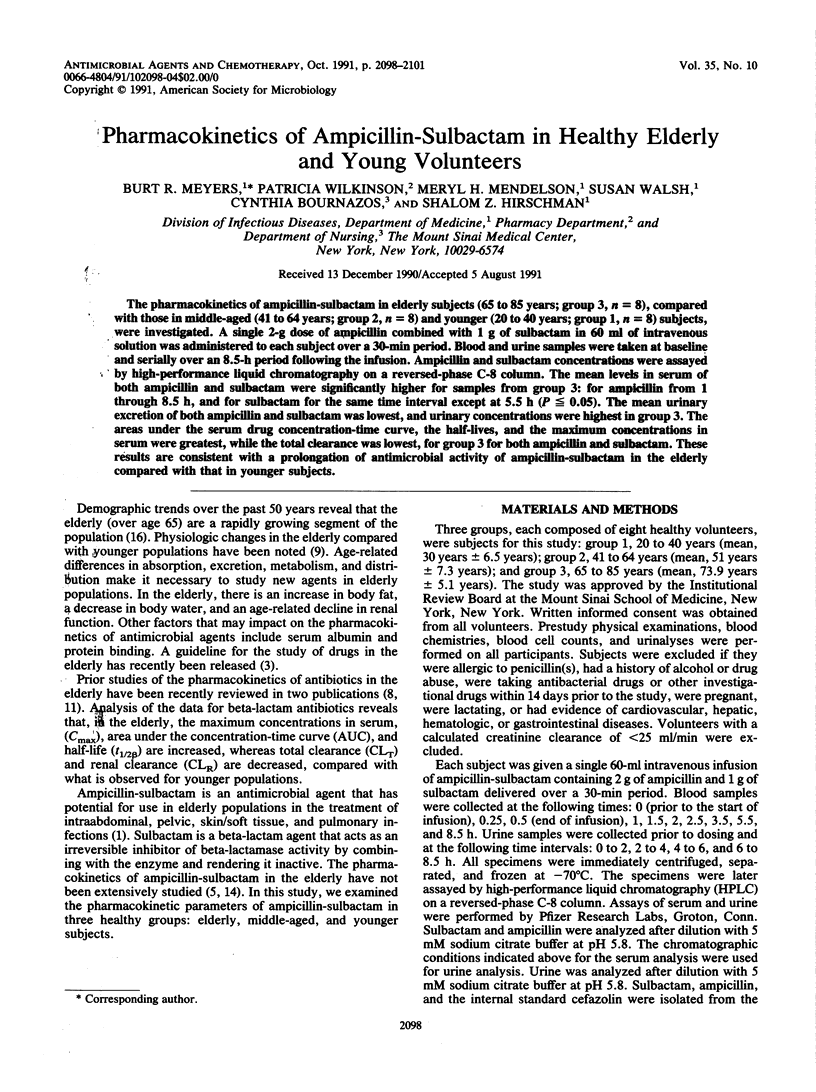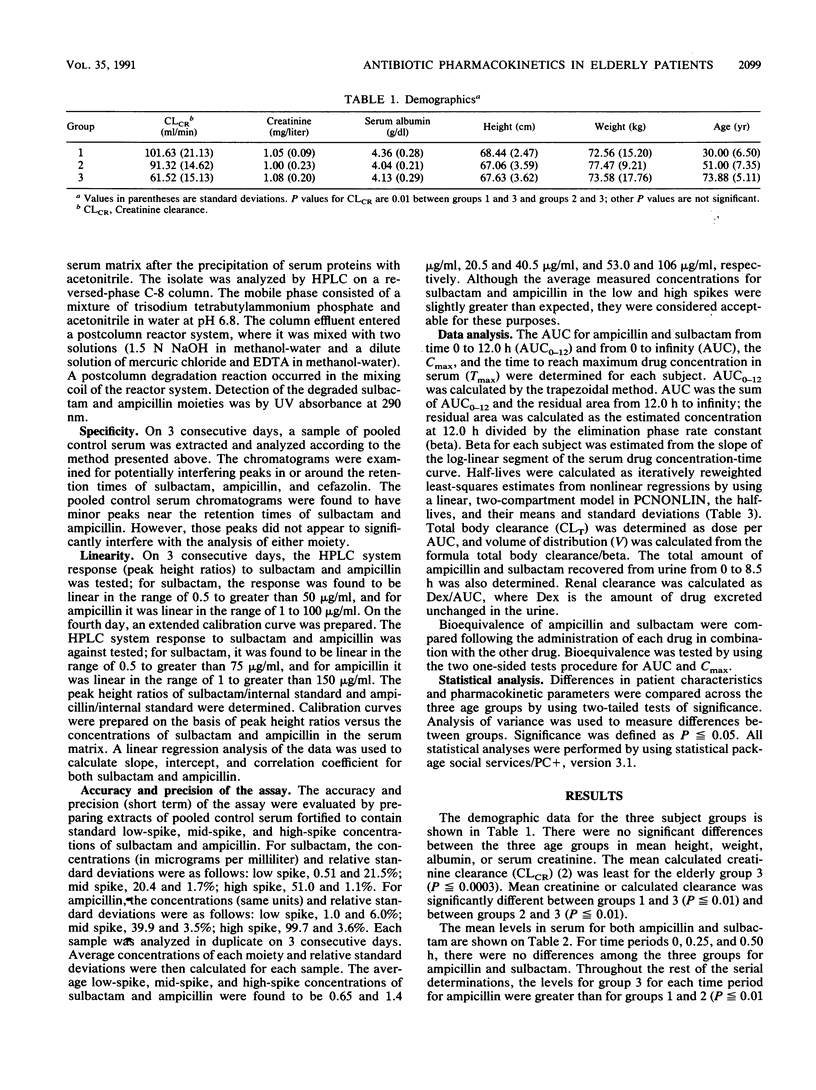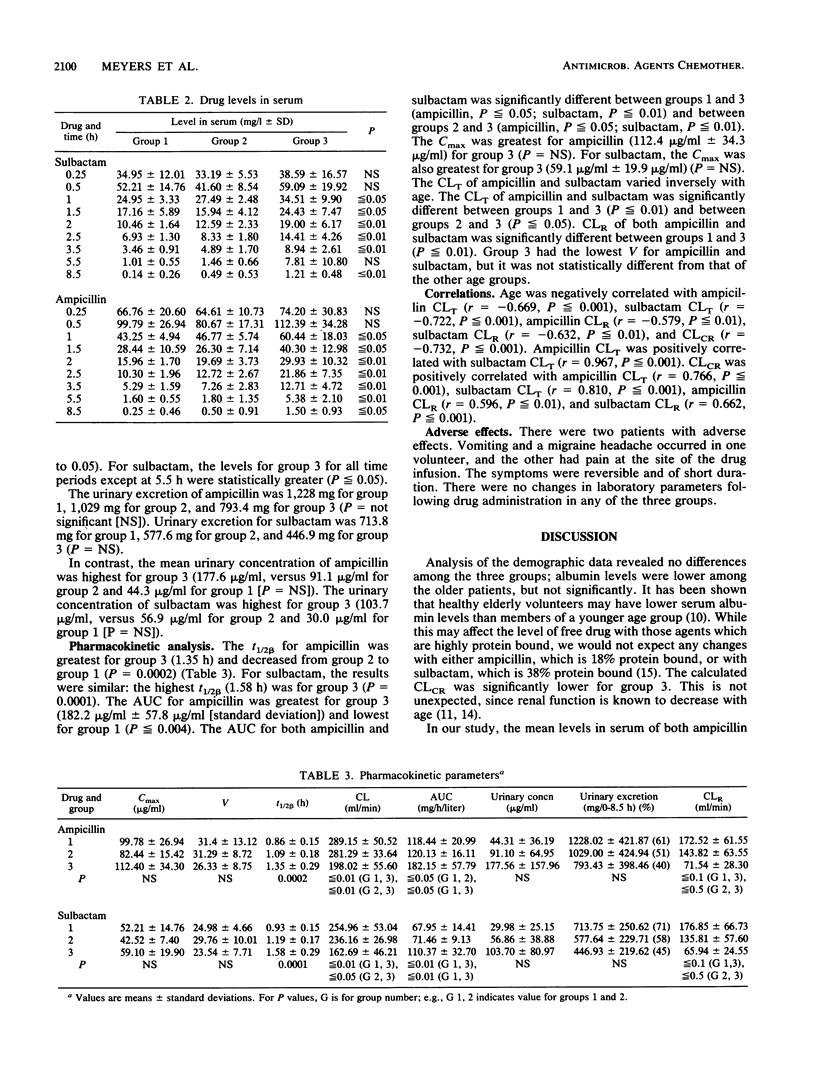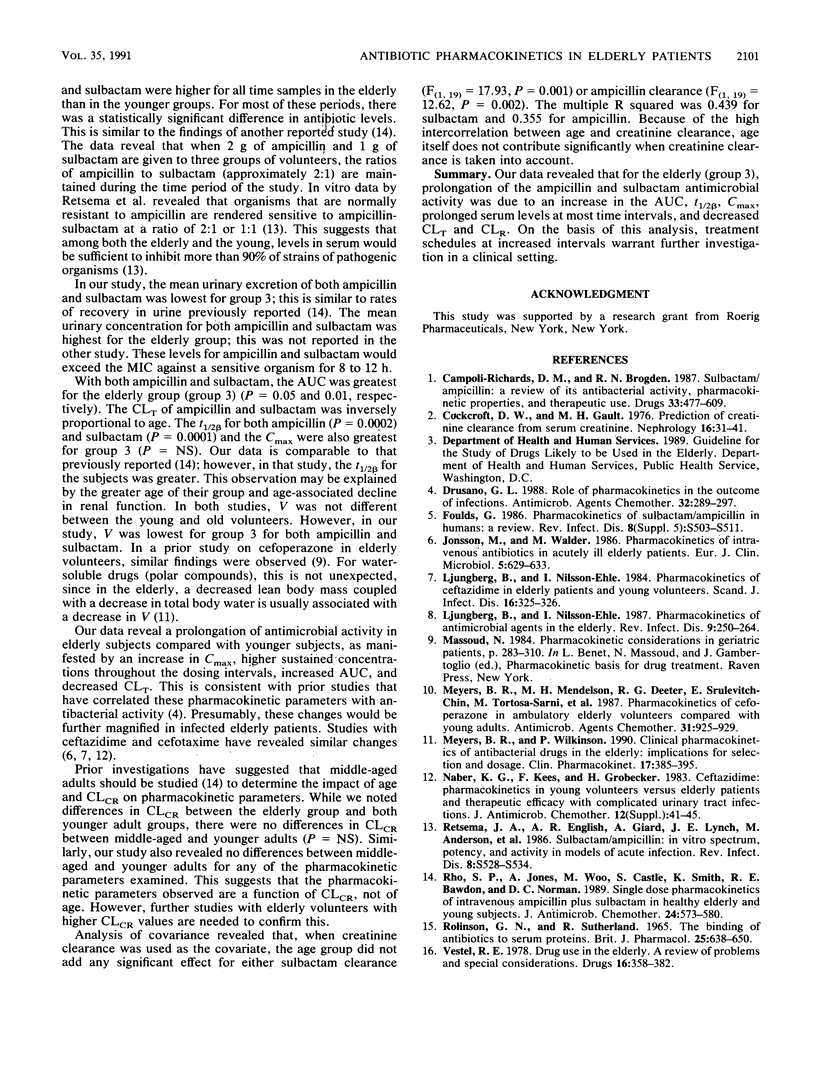Abstract
The pharmacokinetics of ampicillin-sulbactam in elderly subjects (65 to 85 years; group 3, n = 8), compared with those in middle-aged (41 to 64 years; group 2, n = 8) and younger (20 to 40 years; group 1, n = 8) subjects, were investigated. A single 2-g dose of ampicillin combined with 1 g of sulbactam in 60 ml of intravenous solution was administered to each subject over a 30-min period. Blood and urine samples were taken at baseline and serially over an 8.5-h period following the infusion. Ampicillin and sulbactam concentrations were assayed by high-performance liquid chromatography on a reversed-phase C-8 column. The mean levels in serum of both ampicillin and sulbactam were significantly higher for samples from group 3: for ampicillin from 1 through 8.5 h, and for sulbactam for the same time interval except at 5.5 h (P less than or equal to 0.05). The mean urinary excretion of both ampicillin and sulbactam was lowest, and urinary concentrations were highest in group 3. The areas under the serum drug concentration-time curve, the half-lives, and the maximum concentrations in serum were greatest, while the total clearance was lowest, for group 3 for both ampicillin and sulbactam. These results are consistent with a prolongation of antimicrobial activity of ampicillin-sulbactam in the elderly compared with that in younger subjects.
Full text
PDF



Selected References
These references are in PubMed. This may not be the complete list of references from this article.
- Campoli-Richards D. M., Brogden R. N. Sulbactam/ampicillin. A review of its antibacterial activity, pharmacokinetic properties, and therapeutic use. Drugs. 1987 Jun;33(6):577–609. doi: 10.2165/00003495-198733060-00003. [DOI] [PubMed] [Google Scholar]
- Cockcroft D. W., Gault M. H. Prediction of creatinine clearance from serum creatinine. Nephron. 1976;16(1):31–41. doi: 10.1159/000180580. [DOI] [PubMed] [Google Scholar]
- Drusano G. L. Role of pharmacokinetics in the outcome of infections. Antimicrob Agents Chemother. 1988 Mar;32(3):289–297. doi: 10.1128/aac.32.3.289. [DOI] [PMC free article] [PubMed] [Google Scholar]
- Foulds G. Pharmacokinetics of sulbactam/ampicillin in humans: a review. Rev Infect Dis. 1986 Nov-Dec;8 (Suppl 5):S503–S511. doi: 10.1093/clinids/8.supplement_5.503. [DOI] [PubMed] [Google Scholar]
- Jonsson M., Walder M. Pharmacokinetics of intravenous antibiotics in acutely ill elderly patients. Eur J Clin Microbiol. 1986 Dec;5(6):629–633. doi: 10.1007/BF02013286. [DOI] [PubMed] [Google Scholar]
- Ljungberg B., Nilsson-Ehle I. Pharmacokinetics of antimicrobial agents in the elderly. Rev Infect Dis. 1987 Mar-Apr;9(2):250–264. doi: 10.1093/clinids/9.2.250. [DOI] [PubMed] [Google Scholar]
- Ljungberg B., Nilsson-Ehle I. Pharmacokinetics of ceftazidime in elderly patients and young volunteers. Scand J Infect Dis. 1984;16(3):325–326. doi: 10.3109/00365548409070410. [DOI] [PubMed] [Google Scholar]
- Meyers B. R., Mendelson M. H., Deeter R. G., Srulevitch-Chin E., Sarni M. T., Hirschman S. Z. Pharmacokinetics of cefoperazone in ambulatory elderly volunteers compared with young adults. Antimicrob Agents Chemother. 1987 Jun;31(6):925–929. doi: 10.1128/aac.31.6.925. [DOI] [PMC free article] [PubMed] [Google Scholar]
- Meyers B. R., Wilkinson P. Clinical pharmacokinetics of antibacterial drugs in the elderly. Implications for selection and dosage. Clin Pharmacokinet. 1989 Dec;17(6):385–395. doi: 10.2165/00003088-198917060-00003. [DOI] [PubMed] [Google Scholar]
- Naber K. G., Kees F., Grobecker H. Ceftazidime: pharmacokinetics in young volunteers versus elderly patients and therapeutic efficacy with complicated urinary tract infections. J Antimicrob Chemother. 1983 Jul;12 (Suppl A):41–45. doi: 10.1093/jac/12.suppl_a.41. [DOI] [PubMed] [Google Scholar]
- Retsema J. A., English A. R., Girard A., Lynch J. E., Anderson M., Brennan L., Cimochowski C., Faiella J., Norcia W., Sawyer P. Sulbactam/ampicillin: in vitro spectrum, potency, and activity in models of acute infection. Rev Infect Dis. 1986 Nov-Dec;8 (Suppl 5):S528–S534. doi: 10.1093/clinids/8.supplement_5.s528. [DOI] [PubMed] [Google Scholar]
- Rho J. P., Jones A., Woo M., Castle S., Smith K., Bawdon R. E., Norman D. C. Single-dose pharmacokinetics of intravenous ampicillin plus sulbactam in healthy elderly and young adult subjects. J Antimicrob Chemother. 1989 Oct;24(4):573–580. doi: 10.1093/jac/24.4.573. [DOI] [PubMed] [Google Scholar]
- Rolinson G. N., Sutherland R. The binding of antibiotics to serum proteins. Br J Pharmacol Chemother. 1965 Dec;25(3):638–650. doi: 10.1111/j.1476-5381.1965.tb01788.x. [DOI] [PMC free article] [PubMed] [Google Scholar]
- Vestal R. E. Drug use in the elderly: a review of problems and special considerations. Drugs. 1978 Oct;16(4):358–382. doi: 10.2165/00003495-197816040-00004. [DOI] [PubMed] [Google Scholar]


